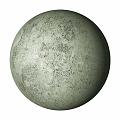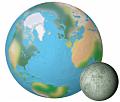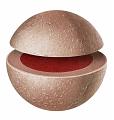THE PLANET MERCURY IS NAMED after the Greco-Roman messenger of the gods, because it circles the Sun faster than the other planets, completing its circuit in 88 Earth days. Because it travels so close to the Sun, Mercury is often difficult to observe. Even though its reflected light makes it one of the brightest objects in the night sky, Mercury is never far enough from the Sun to be able to shine out brightly. It is only visible as a "morning" or "evening" star, hugging the horizon just before or after the Sun rises or sets. Like Venus, Mercury also has phases (p.20). Being so close to the Sun, temperatures during the day on Mercury are hot enough to melt many metals. At night they drop to -291°F (-180aC), making the temperature range the greatest of all the planets. The gravitational pull of the Sun has" stolen" any atmosphere that Mercury had to protect itself against these extremes. Read some facts about Mercury at the bottom, or click here.
Early Mercury Map
Although many astronomers have tried to record the elusive face of Mercury, the most prolific observer was the French astronomer Eugene Antoniadi (1870-1944). His maps, drawn between 1924 and 1929, show a number of huge valleys and deserts. Close-up views by the Mariner 10 space probe uncovered an altogether different picture
Seismic Waves
Some of Mercury's hills and mountains were created by the impact of a huge meteorite. The impact created a crater, known as Caloris Basin, where the meteorite struck the surface and sent out seismic, or shock, waves through the semi-molten core of the planet. These waves traveled through Mercury to the other side, where the crust buckled and mountain ranges were thrown up.
Cratered Terrain
The surface of Mercury closely resembles our crater-covered Moon. Mercury's craters were also formed by the impact of meteorites, and the lack of atmosphere has kept the landscape unchanged. Around the edges of the craters, a series of concentric ridges record how the surface was pushed outward by the force of the impact.
Surface of Mercury
This image is a mosaic of photographs taken during Mariner 10's journey past Mercury in 1974. Mercury seems to have shrunk a great deal after it was formed. This has caused a series of winding ridges, called scarps, that are unique to the planet. The entire surface is heavily cratered. The space probe Mariner 10 also discovered that Mercury has a magnetic field about 1 percent the strength of Earth's magnetic field.
Messenger to Mercury
In 2004, NASA launched the Messenger spacecraft to explore Mercury. After flying past Mercury three times, it will go into orbit around the planet in 2011. It is the first mission to Mercury since Mariner 10 in 1974-75.
Measuring Planets
Whereas we can weigh and measure objects on Earth, we have to assess the space a planet occupies (volume), how much matter it contains (mass), and its density by looking at its behavior, by analyzing its gravitational pull on nearby objects, and by using data gained by space probes (pp.34-35). Density is the mass for every unit of volume of an object (mass divided by the volume).
Comparing Density
Mercury has great mass for its size. Even though it is only slightly larger than Earth's Moon, its mass is four times that of the Moon. This means its density must be nearly as high as Earth's, most likely due to a very high quantity of iron. Astronomers believe that Mercury must have a massive iron core that takes up nearly three-fourths of its radius to achieve such great mass-a fact backed up by Mariner la's evidence of a magnetic field. When the densities of Mercurj and Saturn, the huge gas giant (pp.52-53), are compared, Saturn would float and Mercury, whose density is seven times as great, would sink.
Orbital Period
The tidal force of Earth has locked its Moon into rotating so that one side of the Moon always faces Earth. This means the rotational period of the Moon equals its monthly period of revolution around Earth. Since the orbit of Mercury is elongated, like an oval, it is locked into a rotational period where the planet spins 1Y2times during each orbit of the Sun. This means that its year (how long it takes to orbit the Sun) is 88 Earth days, while its day (the time it takes to rotate-sunrise to sunrise) is 58.6 Earth days.
Facts About Mercury
- Sidereal period 88 Earth days
- Temperature at surface -292'F to 800'F (-180'C to 430'C)
- Rotational period 58.6 Earth days
- Mean distance from the Sun 36 million miles/57.9 million km
- Volume (Earth = 1) 0.056 • Mass (Earth = 1) 0.055
- Density (water = 1) 5.43
- Equatorial diameter 4,879 km/3,030 miles
- Number of satellites 0




